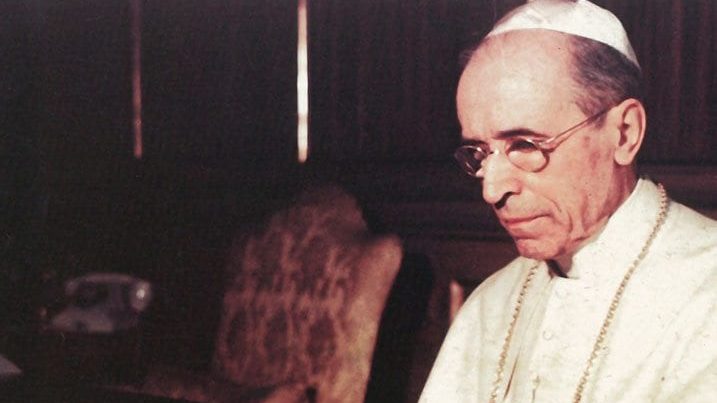When Cardinal Eugenio Maria Giuseppe Giovanni Pacelli was elected Pope Pius XII in 1939, his papacy ushered in a new stage of warmth between the United States and the Holy See which laid a foundation for the eventual establishment of full diplomatic relations.
One of the 20th century’s most controversial popes due to accusations of silence in the face of the Holocaust during the Second World War, Pius XII was once again thrust into the global spotlight with the March 2 opening of his files in the Vatican Apostolic Archives.
Critics of Pius XII, who died in 1958, have argued that he did not do enough to save lives during the Holocaust, and that his refusal to denounce Adolf Hitler allowed more Jews to be killed. However, his defenders have long insisted that the pope was active behind the scenes, saving thousands of lives by hiding Jews in convents and religious communities.
“It is very much an international conversation,” said Susanna De Stradis, the co-director of the Colloquium of Religion and History at the University of Notre Dame.
She told Crux that historians who have explored the question “have shown a similar tendency to that observable in other ‘national’ historiographies: A tendency to divide in a group of apologists versus one of critics.”
However, De Stradis said most serious historical scholars have “more or less acknowledge that the most interesting question is not whether or not Pius XII did ‘enough,’ but rather what the reasons were behind what he did and did not do.”
Many scholars and historians are hoping that the opening of the archives will shed greater light on this question.
De Stradis was scheduled to speak this week at a conference organized by the Pontifical Gregorian University called, “The Holy See and the US in Pius XII’s Archives: The State of the Question and the Archives.”
One of the many events either canceled or postponed as a result of the coronavirus outbreak in Italy, the discussion intended to explore how the opening of the Vatican archives on Pius XII could shed light on the relationship between the United States and the Holy See.
The United States had maintained consular relations with the Papal States from 1797 to 1867, though there was no U.S. ambassador.
In 1867, these relations collapsed due to heightened anti-Catholicism in the United States, which were inflamed by the role of several Catholics in the assassination of Abraham Lincoln. The Papal States ceased to exist in 1870, when the newly unified Italy conquered Rome, freezing the diplomatic rift between Washington and the Holy See.
The Vatican City State came into being with the signing of the Lateran Treaty in 1929, but it was not until 1984 that the United States and the Holy See established full diplomatic relations under U.S. President Ronald Reagan and Pope John Paul II.
Prior to this, several U.S. presidents had named personal envoys to travel to the Holy See for periodic discussions on international humanitarian and political issues.
Myron Charles Taylor, who served Presidents Franklin D. Roosevelt and Harry S. Truman from 1939 to 1950, was envoy to the Vatican during Pius XII’s papacy.
One document contained in the Vatican archive is a hand-signed Oct. 1, 1940, letter from President Roosevelt to Pius XII in which the president praises the pope’s “continuing efforts to find the way to a piece which bears promise not only of permanency, but also of freedom from perpetual alarm and opportunity for the spiritual and material improvement of humanity.”
“It seems imperative that this search shall not be abandoned, no matter how deep may be the shadow of the present strife,” Roosevelt said, adding that “It is equally necessary to realize that peace as Your Holiness conceives it must be based upon the reestablishment of Christian law and doctrine as the guiding principles which govern the relations of free men and free nations.”
“The spiritual freedom and political independence which alone make possible this rebuilding of the structure of peace thus become a necessary part of our common goal,” he told Pius XII, adding that “The whole world needs you in its search for peace and good will.”
De Stradis said at the time World War II began in 1939, “no statesman could reasonably doubt that the Pope was at work to achieve peace.”
“What might have been debatable was whether his taking a tougher stance against Hitler would have hindered or facilitated progress towards peace,” she said, noting that Roosevelt had looked to the Holy See as “a crucial diplomatic hub” and a source for accurate information about the situation in Europe.
In this sense, “Keeping good diplomatic relations with the Vatican…was a key strategic goal,” she said.
Restoration of diplomatic ties between the United States and the Holy See was something that had been underway since the late 1930s, while Pacelli was still serving as Secretary of State to Pope Pius XI. But geopolitical shifts resulting from World War II and then the Cold War, De Stradis said, ended up bringing the two nations “even closer together.”
In terms of the Vatican archives, De Stradis said she is eager to see what the contents might reveal about the Holy See’s increased appreciation for the United States not only as a key ally, but also “as a possible embodiment of what Pope Pius XII envisioned as a ‘sound democracy,’” a term the late pope used in a 1944 Christmas message over the radio.
De Stradis said she is also interested in seeing if the archives will reveal new insights into the Holy See’s perspective on what she called “the self-representation of the U.S. as a God-fearing nation leading the West against atheistic Soviet Union,” as well as the Catholic Church’s growth in post-war America and the role Catholicism played in major political and social questions at the time.

